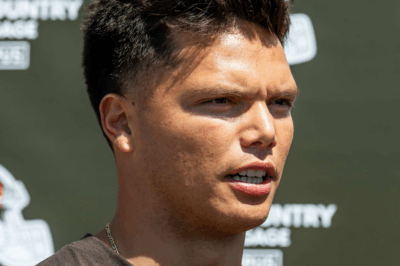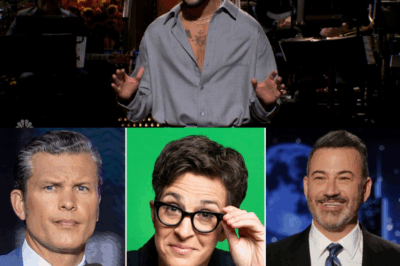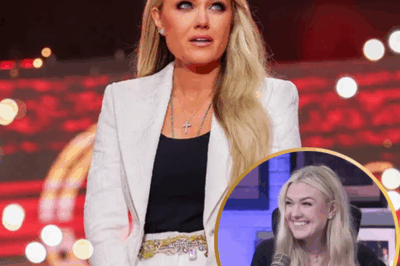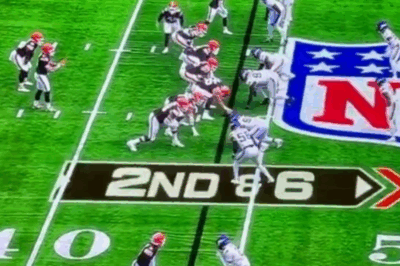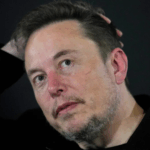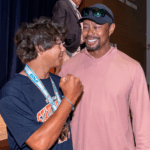Magic Johnson’s Bold Move: How He Hired LA Gang Members to Rebuild the Community
In the heart of Los Angeles, where the streets tell stories of struggle, resilience, and survival, one NBA legend took an unconventional approach to uplift his community.
Earvin “Magic” Johnson, the five-time NBA champion and Hall of Famer, has always been more than just a basketball icon. His impact extends far beyond the courts of the Los Angeles Lakers—into the very neighborhoods that raised him.
In a striking move that surprised many, Magic Johnson made a conscious decision to hire members of the Bloods and Crips—two of the most notorious gangs in Los Angeles—to work at his local businesses.
It wasn’t a publicity stunt or an act of charity, but rather a carefully calculated effort to create lasting change in a city often torn apart by gang violence.
Magic Johnson’s Commitment to Community Development
When Magic Johnson retired from professional basketball, he didn’t disappear into luxury and leave behind the city that cheered for him throughout his career.
Instead, he became a dedicated businessman and philanthropist, focusing on revitalizing urban communities.
His investments in movie theaters, Starbucks franchises, and other business ventures across South Central Los Angeles and other minority-heavy areas created thousands of jobs and stimulated economic growth.
But Johnson knew that money alone wasn’t enough. He had to address the root causes of crime and violence in his community.
Many young men and women turned to gangs not out of choice but out of necessity, often seeing no viable path to legitimate employment.
Without opportunities, they remained trapped in cycles of crime, poverty, and incarceration.
Rather than writing them off as lost causes, Johnson took an unconventional approach: he extended a hand to those whom society had deemed irredeemable.
“I Went and Sat Down With the Bloods and the Crips”
Johnson’s approach was direct and personal. Instead of relying on second-hand information, he went straight to the source.
“I went and sat down with the Bloods and the Crips,” he recalled in interviews. He met with gang leaders and members face-to-face, listening to their stories and understanding the circumstances that led them to their current situations.
His mission was clear—to offer a way out. But he didn’t just offer jobs; he offered dignity, responsibility, and the ability to provide for families through legal means.
This wasn’t a simple process. Many of these individuals had never worked a legal job before.
Some had criminal records that made employment difficult. But Johnson, believing in redemption, took the risk.
Hiring Gang Members: A Risk That Paid Off
Johnson’s businesses—ranging from his Magic Johnson Theatres to Starbucks franchises in urban areas—became places of second chances.
Former gang members, who once found themselves in the midst of violence and crime, were now working as baristas, security guards, cashiers, and managers.
This initiative wasn’t without its challenges. Hiring individuals with a history of gang affiliation meant navigating tensions, ensuring workplace safety, and fostering an environment of mutual respect.
Some employees struggled to adapt to the discipline of a structured work setting, while others faced skepticism from customers and colleagues alike.
However, Johnson’s gamble paid off. Many of the individuals he employed not only turned their lives around but became mentors to others in similar situations.
They learned the value of hard work, customer service, and teamwork—skills that extended far beyond their jobs.
Some even went on to start their own businesses, proving that given the right opportunities, people can change their paths.
A Model for Change in Urban America
Johnson’s hiring approach challenged the conventional methods of addressing gang violence.
While law enforcement focused on crackdowns, arrests, and harsher sentences, Johnson invested in prevention—providing economic alternatives that kept young men and women away from crime in the first place.
His model is one that urban leaders and policymakers have since looked to as a blueprint for sustainable community reform.
By focusing on economic empowerment rather than just punitive measures, he helped break generational cycles of poverty and incarceration.
This initiative wasn’t just about hiring gang members; it was about changing narratives
. Instead of seeing former gang members as problems, Johnson saw them as assets—individuals capable of growth, leadership, and contribution.
The Bigger Picture: Economic Empowerment as Crime Prevention
Magic Johnson’s efforts underscore a broader truth—crime often stems from lack of opportunity.
When neighborhoods are stripped of resources, when schools are underfunded, and when jobs are scarce, crime becomes an almost inevitable outcome.
By injecting business and employment opportunities into historically underserved communities, Johnson tackled the problem at its roots. His philosophy was simple:
Give people a legitimate way to make money, and they won’t need to turn to crime.
His efforts also helped bridge the gap between corporate America and urban communities.
Through his partnerships with major brands like Starbucks, TGI Fridays, and 24 Hour Fitness, Johnson demonstrated that businesses could thrive in Black and Brown neighborhoods—challenging stereotypes that often deterred corporations from investing in inner cities.
Legacy and Lasting Impact
Today, Magic Johnson’s influence as a businessman and community leader is as strong as ever.
His efforts in hiring former gang members were just one piece of his larger mission—to create self-sustaining economic ecosystems in urban communities.
Many of the individuals he employed have gone on to lead productive lives, some even working their way up to managerial positions or becoming business owners themselves.
His impact isn’t just measured in dollars and cents but in transformed lives and safer communities.
Johnson’s decision to sit down with the Bloods and Crips wasn’t just an act of courage—it was an act of leadership.
He saw potential where others saw problems, and in doing so, he changed the course of countless lives.
Conclusion
Magic Johnson’s willingness to engage with gang members and offer them jobs was a groundbreaking move that proved economic empowerment is a powerful tool in reducing crime and building stronger communities.
By hiring individuals who society had often discarded, he not only gave them a second chance but also showed the world that with opportunity, change is possible.
His story serves as a lesson for business leaders, policymakers, and communities alike—real change happens when we invest in people, not just punish them.
And in a city once torn apart by gang rivalries, Magic Johnson’s vision brought something greater than championships to Los Angeles—hope.
News
How did one North Carolina fan become the biggest story of the Clemson game without even stepping on the court? The answer will drop your jaw.
Social Media Has Fallen In Love With Jaw-Dropping North Carolina Fan Who Stole The Show In The Stands During Loss…
VIDEO: Dillon Gabriel’s first move as Browns’ starter? A chilling, direct shot at Shedeur Sanders that has the entire NFL fanbase gasping.
VIDEO: Dillon Gabriel’s first move as Browns’ starter? A chilling, direct shot at Shedeur Sanders that has the entire NFL…
J.K. Rowling’s explosive comments spark a TOTAL OLYMPIC MELTDOWN! Ticket sales are in freefall, and the 2028 Games are on the brink of collapse. You won’t believe the chaos.
J.K. Rowling’s explosive comments spark a TOTAL OLYMPIC MELTDOWN! Ticket sales are in freefall, and the 2028 Games are on…
Bad Bunny fires a shocking warning shot to Super Bowl viewers who don’t understand him, mocking the “right-wing backlash” to his historic halftime show.
Bad Bunny fires a shocking warning shot to Super Bowl viewers who don’t understand him, mocking the “right-wing backlash” to…
BREAKING: Erika Kirk breaks her silence with a shocking message to the “fans” questioning her grief. You don’t know the whole story. The timeline you’re demanding doesn’t exist.
BREAKING: Erika Kirk breaks her silence with a shocking message to the “fans” questioning her grief. You don’t know the…
The NFL just made a massive mistake on live TV. The “script” for the Browns-Vikings game was accidentally revealed, and fans are losing their minds. You have to see the video.
The NFL just made a massive mistake on live TV. The “script” for the Browns-Vikings game was accidentally revealed, and…
End of content
No more pages to load



